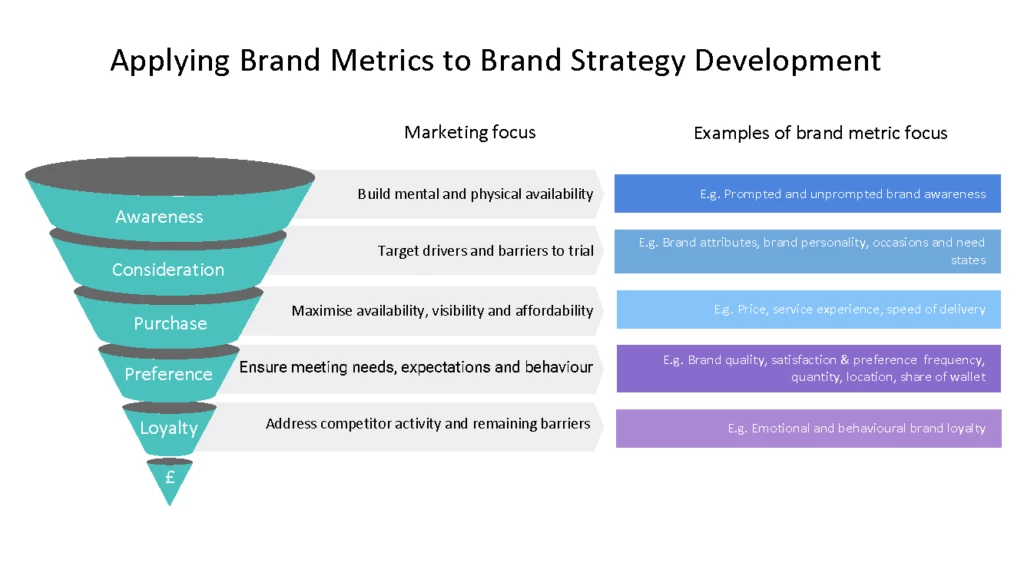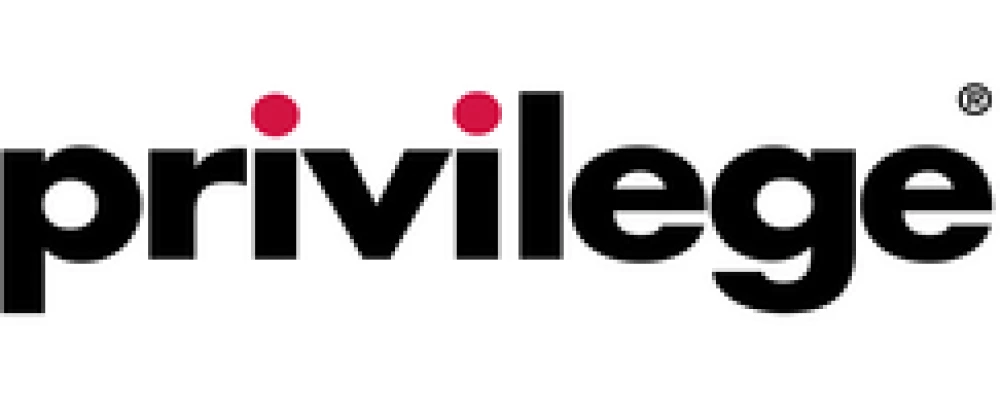Table of Contents
12 Important Brand Tracking Metrics
First, here’s a quick list of the 12 important brand tracking metrics that we cover in this article:
Unprompted brand awareness
Prompted brand awareness
Emotional brand loyalty
Brand attributes
Brand personality
Need states
Brand quality
Brand satisfaction
Behavioural brand loyalty
Brand preference
Brand purchase
Brand usage occasions
What are brand tracking metrics?
In this article, we explore in detail what brand tracking metrics are and how they are used to monitor brand health. Brand health can be influenced by many things, and key brand tracking metrics can be analysed through brand tracking projects.
The term brand metrics refers to the different metrics that are derived from the questions typically included within a brand tracker.
A brand tracker is a form of ongoing market research survey used to assess your brand’s health and the impact of your marketing activity.
The results of a single brand tracker wave provide a snapshot of brand health. Results are presented for each brand tracking metric (e.g. brand awareness, brand loyalty) individually, but can also be rolled into a single, overall brand health score.
Why are brand tracking metrics important?
Your brand’s health ultimately depends on the extent to which consumers:
- are aware of your brand
- can bring it to mind in a purchase situation
- feel that it meets their needs
- are subsequently willing to (re-)purchase it
As a brand manager, without suitable, up-to-date brand tracking metrics, you are almost certainly working in the dark – lacking the critical insights required to target the issues that are undermining your brand’s ability to grow.
In addition, your brand is also more likely to be susceptible to targeted activity by competitors that are closely monitoring it, as part of their own brand-tracking activity. I.e you might not be tracking your brand at the moment, but your competitors might be tracking their own brands and yours, positioning themselves to capitalise on any opportunities.
However, by comparing brand metrics across different tracker waves over time, you can quickly identify any significant changes, so that targeted action can be taken to improve your brand’s performance, in relation to:
- customer satisfaction
- market share
- brand loyalty
- lifetime value
Figures provided by InMoment demonstrate the importance of managing these issues closely:
- Nearly 50% say that they have rejected a brand to go to a competitor which they felt was better able to meet their needs
- 75% of loyal customers say they are likely to recommend their favoured brand to others
Brand tracking metric selection criteria
Of course, the ability of your brand tracker to drive meaningful brand growth will depend on whether you have selected the right brand metrics in the first place.
The brand tracking metrics you choose should:
- Reflect your long-term brand strategy, rather than short-term brand tactics.
- Be customer-centric, meaning that they accurately analyse your brand from the point of view of the target audience, rather than the way your organisation thinks about it internally.
- Compare the performance of your brand to those of established and upcoming competitors. Reviewing your brand in a vacuum will provide a very misleading view of brand health.
- Be actionable. Metrics that are ‘interesting’ but can’t be acted upon are of no use.
- Be flexible. At least 80% of your brand metrics should be constant and repeated with each wave. However, your tracker can also include a flexi-section, where individual metrics can be changed on a wave-by-wave basis. This flexibility ensures that your tracker is always able to take full account of changing market conditions and any campaign activity that could influence results.
- Encompass your brand’s distribution strategy. To obtain a realistic picture of overall brand performance, the tracker questions resulting metrics should be applicable to all channels and touchpoints used by the brand.
- Be concise. Historically, brand trackers have tended to be too long! The more brand tracking metrics that are included, the more chance there is that the person completing the tracker will lose interest.
Types of Brand Metrics
Core brand tracking metrics can be divided into 3 groups: brand awareness, brand closeness and brand behaviour.
Brand awareness
This group assesses the ease and speed with which your brand is brought to mind by the target audience. It comprises:
- Unprompted brand awareness
- Prompted brand awareness
Brand closeness
This group focuses on the nature and extent of the relationship between brand and consumer. It includes:
- Emotional brand loyalty
- Brand attributes
- Brand personality
- Brand need states
- Brand quality
- Brand satisfaction
Brand behaviour
This group is concerned with the more functional aspects of the consumer’s behavioural relationship with your brand. Specific metrics include:
- Brand usage occasions
- Brand preference
- Brand purchase frequency
- Behavioural brand loyalty
Not all of these metrics may be relevant or important to your brand. The trick is to work out in advance which ones are, and how you will use the insights they provide.
Brand awareness metrics
In this section, we look at each group in more detail, and provide example tracker questions from which the individual brand tracking metrics can be derived.
Unprompted brand awareness
Quite simply, if your brand is more top-of-mind than others then it stands a better chance of being purchased.
The unprompted brand awareness metric reveals the extent to which your brand comes to mind – in the context of the sector in which it operates – without being prompted by name.
Unprompted brand awareness example question:
Thinking about brands in the [INSERT CATEGORY HERE], which brand first comes to mind? And which other brands come to mind?
If consumers are unable to recall your brand at an unprompted level, this indicates that it hasn’t yet succeeded in permeating the conscious mind and only resides in their subconscious – if at all.
Prompted brand awareness
In the brand tracker, the prompted brand awareness question typically follows the unprompted one. If there is a low level of unprompted awareness, its inclusion is particularly important, to determine whether the brand even exists in the consumer’s subconscious mind.
In a prompted brand awareness question, a shortlist of brands (including yours) is provided for the respondent to select from. For example:
Looking at the list of brands below, before today, which were you aware of?
Clearly, if this question results in a low score as well, then it means that your brand hasn’t yet achieved threshold levels of consumer awareness and has a considerable amount of work to do amongst the target audience.
Brand closeness metrics
Emotional brand loyalty
Brand loyalty is often seen as the most important metric for most brands! A loyal customer will keep purchasing from you and is more likely to forgive the occasional brand slip-up. Moreover, once the fundamentals are in place, it can cost far less to retain a loyal customer than it does to convert a new one.
In reality, there are actually two brand loyalty metrics; emotional brand loyalty and behavioural brand loyalty (discussed in more detail later).
Whilst the two metrics are usually in-step (i.e. if someone is emotionally loyal to your brand they are likely to display the same level of loyalty in their purchase and usage behaviour), they can become detached from each other.
For example, the iPhone is a social phenomenon that commands a high degree of emotional loyalty. However, its high cost may still prevent emotional loyalists from buying the latest model.
Emotional brand loyalty is often assessed using the classic Net Promoter Score question:
On a scale of 0-10, how likely are you to recommend [brand] to your family and friends?
In your own words can you tell us why you gave [brand x] a score of [insert score selected here]?
Brand attributes
How do consumers perceive your brand and its associated attributes, such as performance, reliability, and uniqueness? What comes to mind when they think of your brand and does that image reflect the one that your organisation has worked hard to create?
The ability of customers to associate specific attributes with your brand is important because they establish brand relevance, create memorability, and can even act as prompts to brand recall at the moment of purchase.
Positive brand attributes are often the result of carefully crafted marketing campaigns, but they can also reflect the use of striking packaging or a distinctive font.
A brand attributes question will typically include rating scale statements for each attribute to be assessed. For example:
Thinking about [BRAND X] how strongly do you agree with each of these statements? Please use the 5-point scale where 5 means completely and 1 means not at all.
Brand personality
This metric is closely linked to the brand attributes metric outlined above, but the questions that underlie it focus on the brand’s personality. For example, whether the brand is perceived as being ‘warm’, ‘caring’, ‘smart’, etc.
Whilst your brand’s personality is mainly derived from its marketing, it can also be inferred by customers through their experience of buying and using your product/service (versus those of your competitors), through social media and even word of mouth.
Not only does your brand’s perceived personality reveal the extent to which you have been successful in creating emotional resonance, it can also determine the extent to which it is seen to be similar to, or different from, its competitors.
The absence of key brand personality traits provides a clear understanding of where the brand needs to develop its profile if it is to increase top-of-mind awareness, resonance, and differentiation.
Example question:
Thinking about [BRAND X], how well do you associate it with the following characteristics?
Please use the 5-point scale where 5 means completely and 1 means not at all.
Need states
The need states tracker questions are used to evaluate the perceived suitability of your brand in relation to their needs and expectations. Needs can be either practical or emotional in nature.
Using yoghurt as an example, some consumers may need a low-fat healthy probiotic yoghurt to fulfil their need for physical fitness and well-being, whereas others may need a tasty treat with chocolate pieces to fulfil their need for indulgence that is still perceived as healthy.
Example question:
How well do you believe [BRAND X], meets the following requirements?
Please use the 5-point scale where 5 means completely and 1 means not at all
Brand quality
No matter how well you market your brand, if the customer’s actual experience of it is underwhelming, they are far less likely to repurchase or become brand loyalists.
When assessing brand quality, it is important to consider the issue from the point of view of the customer and the features and benefits that are of most importance to them.
For example, a brand that commands a premium price on the basis that it offers a lifetime guarantee is of little interest to a customer who is looking for a cost-effective, ‘quick fix’.
Conversely, a brand that promises years of service, only to break down or become redundant within a year or two is likely to result in future brand rejection.
The criteria used by the consumer to assess your brand’s quality may include, amongst others, the following:
- Performance
- Reliability
- Durability
- Appearance and finish
- Style
- Fit
To identify perceptions of brand quality, the following questions may be asked:
How would you describe our products to a friend or family member?
If you had to describe our brand in five words, which words would you choose?
Brand satisfaction
The satisfaction metric reflects the totality of the consumer’s interactions with the brand. For this reason, it is regarded by many organisations as one of the most important, along with brand loyalty.
A typical brand satisfaction metric question would be:
Overall, on a scale of 0 to 10, how satisfied are you with [brand X]?
However, this can provide a fairly ‘blunt’ measure of overall satisfaction and can actually obscure lurking issues. Therefore, it is best to supplement it with other questions that address the individual issues that can affect overall brand satisfaction and loyalty.
For example:
- Price
- Customer service
- Staff behaviour
- Product or service availability
- Speed of delivery
Behavioural brand tracking metrics
Behavioural brand loyalty
Unlike emotional brand loyalty, the behavioural loyalty metric reveals the extent to which customers will actually purchase your brand in preference to others, rather than being simply emotionally wedded to it.
High levels of behavioural loyalty are important to manage the cost of customer acquisition and retention. They are also more likely to result in the spread of positive word of mouth about your brand.
A typical brand loyalty question:
Thinking about [BRAND X], which of the statements below would you most agree with?
- It’s the only brand I would buy
- It’s one of a few brands I would buy
- It’s one of a wide range of brands I would buy
- It’s not a brand I would buy
Brand preference
Brand preference is a brand tracking metric used to record the number of customers who would select your brand ahead of named competitors when presented with a brand list. As such, it provides a clear understanding of your brand’s appeal within the context of the wider marketplace.
The question can be as simple as:
Tick which brand of [product] you prefer to buy…OR
If you had to choose just one of these brands the next time you are ready to make a purchase, which one would you choose?
Brand preference is a very useful indicator of overall brand strength because it usually reflects positive sentiment across a number of other key brand metrics, including brand awareness, brand associations and brand quality.
However, it doesn’t explicitly take price into account, and this is a criterion that could still see the consumer selecting another, cheaper brand ahead of their preferred one.
Brand purchase – including frequency
Brand purchase metrics are used to determine purchase behaviours.
For example:
- Frequency – how often an individual customer purchases your brand
- Quantity – how much is purchased on each occasion
- Location – where purchases are made
- Share of wallet – how much of a consumer’s spend is devoted to a particular brand
The results are used to monitor overall sales patterns, to assess the impact of any market activity that has taken place (e.g. a communications campaign, an offer or price change), and to identify any unusual purchasing behaviour.
They can also be used as the basis for future financial and logistical planning and in association with competitor data they can be used to calculate market share.
Typical brand purchase metric questions could be:
On average, how often do you purchase [BRAND X]?
When you buy [BRAND X] on a typical occasion, how many [packs, units, pieces] would you usually buy?
Thinking about the different places you can buy [BRAND X} from, which of these would you consider?
Imagine you were buying [CATEGORY X] for a whole year, how many times would you buy each brand?
Brand usage occasions
Brand usage metrics are used to determine how and when the brand is actually being used by consumers.
They can be used to identify and quantify the different usage occasions, the individual need states that correspond to each of those occasions, the extent to which the brand is able to address each of those need states, and the volume of brand consumption on each occasion.
These metrics enable you to ensure that your product and brand communications are appropriately configured to address consumer needs and behaviour.
A typical brand occasions metric question would be:
Example Question:
Thinking about the range of occasions below, in which ones do you feel [BRAND X] is appropriate?

Which brand metrics should you track?
In this article we’ve described the brand tracking metrics most commonly used in brand trackers today, but you may not need to use all of them to monitor the health of your own brand. You should select the brand metrics that you track based on what you want to achieve with your brand tracking research.
A brand tracking agency like Brandspeak can help you choose which brand metrics you should be tracking, and will help you to use metrics to create an effective brand tracker.
Conclusion
In this article we have outlined the tried and trusted brand tracking metrics most commonly in use today, as well as a host of possible survey questions that you can use to measure these metrics.
As we have shown, many are interlinked, with their power lying in the composite picture of brand health that they provide.
However, individual metrics can also be used together with other forms of sales data, to identify and address specific challenges and opportunities at different stages in the relationship between brand and customer.
Whilst their role and prominence will vary on a brand-by-brand and strategy-by-strategy basis, the chart below shows where and how individual brand metrics can be considered, together with other data, to monitor and support the marketing focus at different stages of the customer relationship, in order to maximise loyalty and share of wallet.
As a brand tracking agency, it is Brandspeak’s job to work with you to:
- Identify the most appropriate brand tracking metrics for your brand and strategy.
- Ensure each, underlying question is as closely aligned to your brand and its position in the market as possible.
- Advise on the most suitable brand tracking frequency.
- Provide an overall brand health score that best reflects your sector and your place in it.
- Use the brand tracking metrics as a diagnostic tool to provide you with the best guidance to help achieve your business and brand goals.
For more information about how brand tracking metrics can be used to transform your brand, get in touch with our team of expert researchers today.














